Ancient Tattoos
Red-Figure Vessel
Wednesday, October 09, 2013
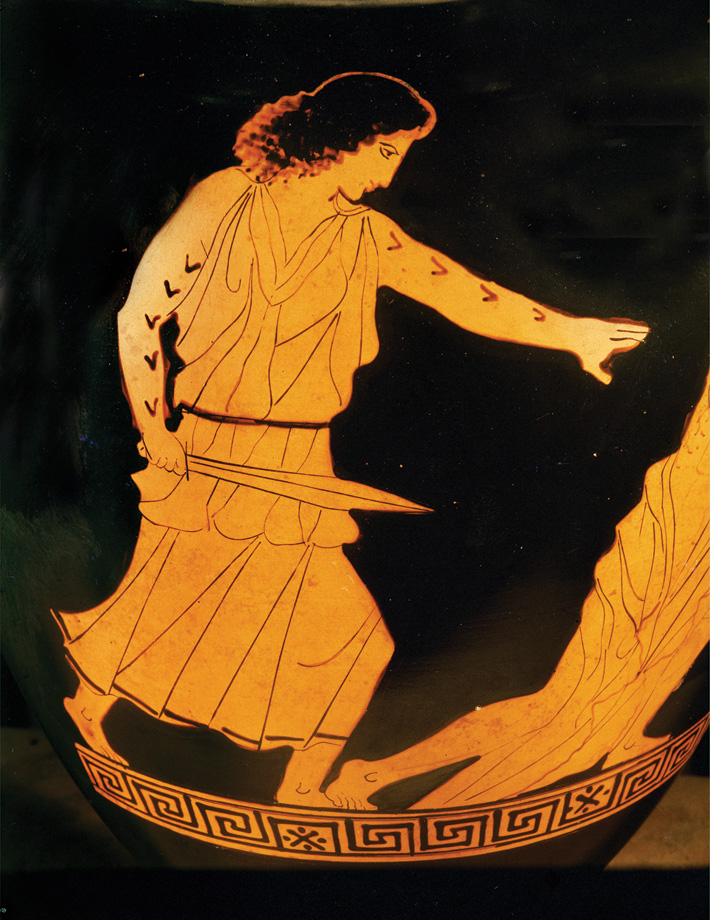 In most of the ancient Greco-Roman world, tattoos were seen as a mark of punishment and shame. The Greeks, who, according to the historian Herodotus, learned the idea of penal tattoos from the Persians in the sixth century B.C., tattooed criminals, slaves who tried to escape, and enemies they vanquished in battle. A famous example has the Athenians tattooing the defeated Samians with an owl, Athens’ hallowed emblem, only to have the favor returned when the Samians defeated the Athenians and tattooed their prisoners with a Samian warship. In the Roman Empire, slaves were marked to show their taxes had been paid. The emperor Caligula tattooed gladiators—as public property—and early Christians condemned to the mines. But among many of the ancient cultures the Greeks and Romans encountered—Thracians, Scythians, Dacians, Gauls, Picts, Celts, and Britons, to name a few—tattoos were seen as marks of pride. Herodotus tells us that for the Thracians, tattoos were greatly admired and “tattooing among them marks noble birth, and the want of it low birth.” A fifth-century B.C. Greek vase (left) depicts a tattooed Thracian maenad, a female follower of the god Dionysus, killing the musician Orpheus as punishment for abandoning Dionysus to worship the sun god, Apollo.
In most of the ancient Greco-Roman world, tattoos were seen as a mark of punishment and shame. The Greeks, who, according to the historian Herodotus, learned the idea of penal tattoos from the Persians in the sixth century B.C., tattooed criminals, slaves who tried to escape, and enemies they vanquished in battle. A famous example has the Athenians tattooing the defeated Samians with an owl, Athens’ hallowed emblem, only to have the favor returned when the Samians defeated the Athenians and tattooed their prisoners with a Samian warship. In the Roman Empire, slaves were marked to show their taxes had been paid. The emperor Caligula tattooed gladiators—as public property—and early Christians condemned to the mines. But among many of the ancient cultures the Greeks and Romans encountered—Thracians, Scythians, Dacians, Gauls, Picts, Celts, and Britons, to name a few—tattoos were seen as marks of pride. Herodotus tells us that for the Thracians, tattoos were greatly admired and “tattooing among them marks noble birth, and the want of it low birth.” A fifth-century B.C. Greek vase (left) depicts a tattooed Thracian maenad, a female follower of the god Dionysus, killing the musician Orpheus as punishment for abandoning Dionysus to worship the sun god, Apollo.
Moche Mask and Mummy
Wednesday, October 09, 2013
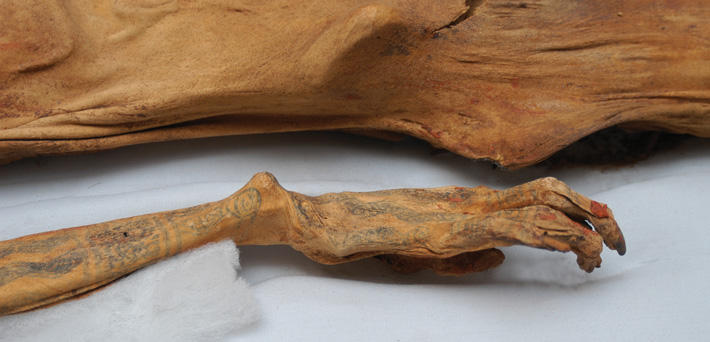
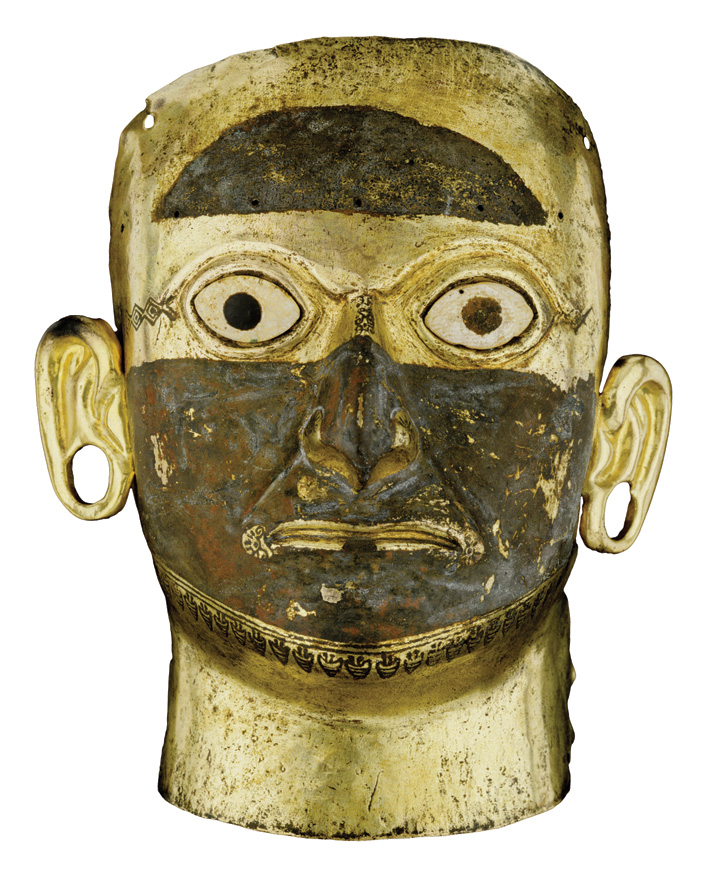 The Moche culture of ancient Peru is noted for elaborately decorated ceramics, goldwork, textiles, and murals—and people. While actual physical evidence of tattooing is rare, there are a great number of artifacts indicating that tattooing was likely a common and esteemed practice in the Moche world, according to Edward Swenson of the University of Toronto. Swenson believes that while it’s possible that the markings on the gold mask (left), for example, may represent actual tattoos, they more likely may be stylized “faux” tattoos that were not inscribed on the face of the deceased buried with the mask but, rather, were symbolic of his identity and life force. One interesting motif that is often found is a string of pupating flies ringing the neck, which Swenson believes symbolizes death and rebirth. “If the fly necklace can be interpreted as a kind of tattoo, then I would suspect some individuals were tattooed in important life-crisis rituals, such as after initiates successfully achieved a new social or ritual status,” explains Swenson. “Similarly, shamans are often depicted with anthropomorphized animals, perhaps suggesting their ability to shape-shift in states of trance.” Animals, both realistic and supernatural, also adorn the body of the “Lady of Cao” (top), a well-preserved mummy found at the site of El Brujo in 2005. Her tattoos include stylized catfish, spiders, crabs, felines, snakes, and a supernatural being commonly called the Moon Animal. “We can only speculate about the meaning of these motifs,” says John Verano of Tulane University, who excavated the mummy with El Brujo Project and Museum director Régulo Franco. “But spiders are associated with rain, as well as with human sacrifice and death, and the serpent is an important element associated in many ancient Andean cultures with deities, fertility, and human sacrifice as well,” adds Verano. “Tattoos may very well have been embraced for aesthetic reasons in Moche society, but they probably also played a fundamental role in facilitating transformations into new states of being,” says Swenson.
The Moche culture of ancient Peru is noted for elaborately decorated ceramics, goldwork, textiles, and murals—and people. While actual physical evidence of tattooing is rare, there are a great number of artifacts indicating that tattooing was likely a common and esteemed practice in the Moche world, according to Edward Swenson of the University of Toronto. Swenson believes that while it’s possible that the markings on the gold mask (left), for example, may represent actual tattoos, they more likely may be stylized “faux” tattoos that were not inscribed on the face of the deceased buried with the mask but, rather, were symbolic of his identity and life force. One interesting motif that is often found is a string of pupating flies ringing the neck, which Swenson believes symbolizes death and rebirth. “If the fly necklace can be interpreted as a kind of tattoo, then I would suspect some individuals were tattooed in important life-crisis rituals, such as after initiates successfully achieved a new social or ritual status,” explains Swenson. “Similarly, shamans are often depicted with anthropomorphized animals, perhaps suggesting their ability to shape-shift in states of trance.” Animals, both realistic and supernatural, also adorn the body of the “Lady of Cao” (top), a well-preserved mummy found at the site of El Brujo in 2005. Her tattoos include stylized catfish, spiders, crabs, felines, snakes, and a supernatural being commonly called the Moon Animal. “We can only speculate about the meaning of these motifs,” says John Verano of Tulane University, who excavated the mummy with El Brujo Project and Museum director Régulo Franco. “But spiders are associated with rain, as well as with human sacrifice and death, and the serpent is an important element associated in many ancient Andean cultures with deities, fertility, and human sacrifice as well,” adds Verano. “Tattoos may very well have been embraced for aesthetic reasons in Moche society, but they probably also played a fundamental role in facilitating transformations into new states of being,” says Swenson.
Head Effigy Pot
Wednesday, October 09, 2013
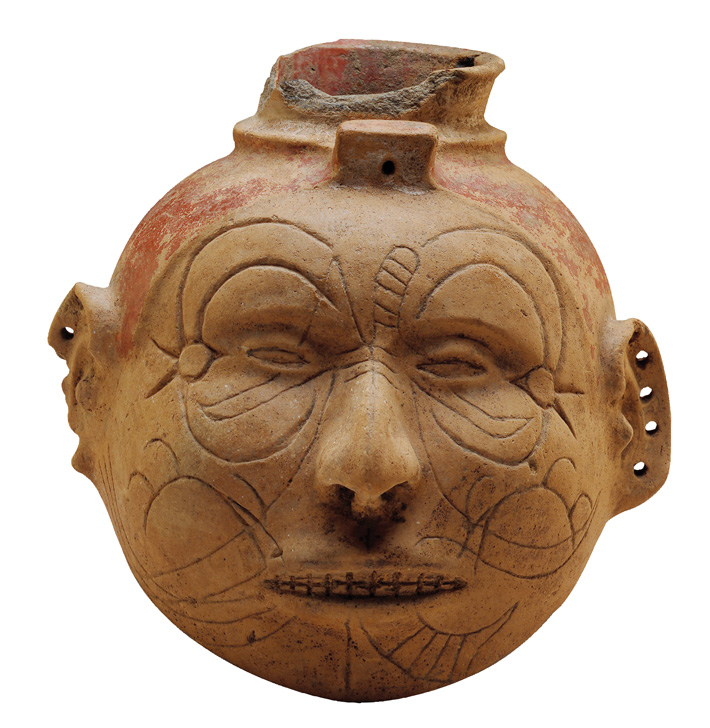 From about A.D. 1200 to 1600, Native Americans speaking very different languages and living across a vast swath of what is now the United States followed similar religious practices known today as the Southeastern Ceremonial Complex. According to David H. Dye of the University of Memphis, who has studied both ritual depictions on artifacts and the Native American oral traditions, tattooing was a vital part of these shared religious ideas. “They played a role in celebrating the perpetuation of life,” says Dye. “For warriors, facial tattoos were snares for capturing the soul of someone they killed in battle. Capturing those enemy souls through permanent tattoos helped extend not only their own lives, but helped ease the passage of their dead relatives.” Much of the evidence for tattooing comes from ceramic pots that depict heavily tattooed human heads. These vessels were often decorated with bird motifs, which seem to relate to the Birdman, a deity who ensured the daily rebirth of the sun and symbolized the triumph of life over death. Often these tattoos took the form of feathers or raptor claws around the eyes. “By tattooing themselves with bird motifs, they became that supernatural creature,” says Aaron Deter-Wolf of the Tennessee Division of Archaeology. “The tattoos enabled them to embody his force.”
From about A.D. 1200 to 1600, Native Americans speaking very different languages and living across a vast swath of what is now the United States followed similar religious practices known today as the Southeastern Ceremonial Complex. According to David H. Dye of the University of Memphis, who has studied both ritual depictions on artifacts and the Native American oral traditions, tattooing was a vital part of these shared religious ideas. “They played a role in celebrating the perpetuation of life,” says Dye. “For warriors, facial tattoos were snares for capturing the soul of someone they killed in battle. Capturing those enemy souls through permanent tattoos helped extend not only their own lives, but helped ease the passage of their dead relatives.” Much of the evidence for tattooing comes from ceramic pots that depict heavily tattooed human heads. These vessels were often decorated with bird motifs, which seem to relate to the Birdman, a deity who ensured the daily rebirth of the sun and symbolized the triumph of life over death. Often these tattoos took the form of feathers or raptor claws around the eyes. “By tattooing themselves with bird motifs, they became that supernatural creature,” says Aaron Deter-Wolf of the Tennessee Division of Archaeology. “The tattoos enabled them to embody his force.”
Hollow Ceramic Figurines
Wednesday, October 09, 2013
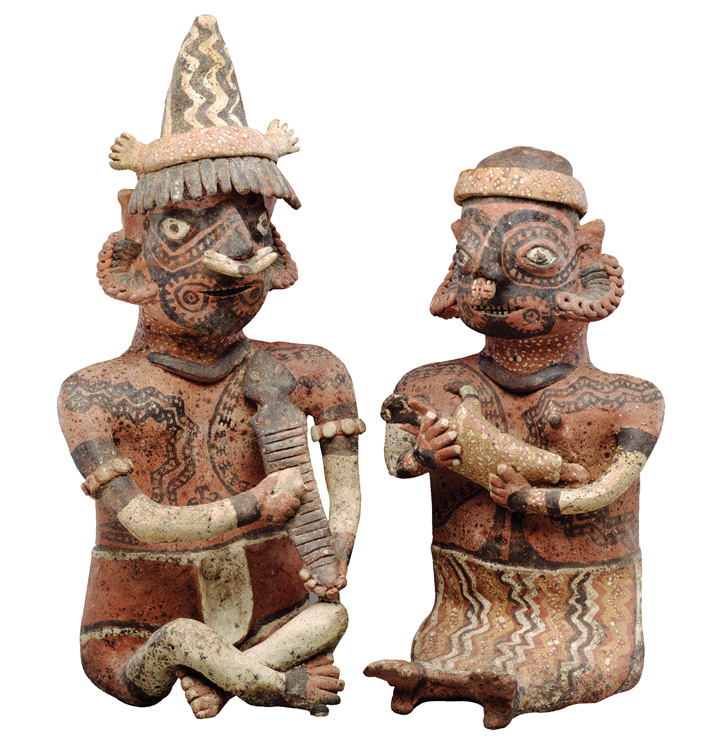
For more than 1,000 years, a culture flourished in what are now the western Mexican states of Jalisco, Nayarit, and parts of Colima. Most of what we know about the culture comes from artifacts taken from shaft tombs—usually by tomb raiders—including examples of heavily tattooed hollow ceramic figurines. Some scholars believe the figurines depict gods, while Christopher Beekman of the University of Colorado Denver suspects that they may in fact represent the people with whom they were buried. Certainly the designs were intended to communicate identity and status, particularly considering that the figurines appear to have been used in ceremonial contexts, and also set up in residential areas to be seen and visited. According to Beekman, it is notable that the tattooing occurs prominently around the mouth, which may refer, as it does in Classic Maya society, to the breath of life or the capacity of polished speech of these individuals.
Ibaloi Mummy
Wednesday, October 09, 2013
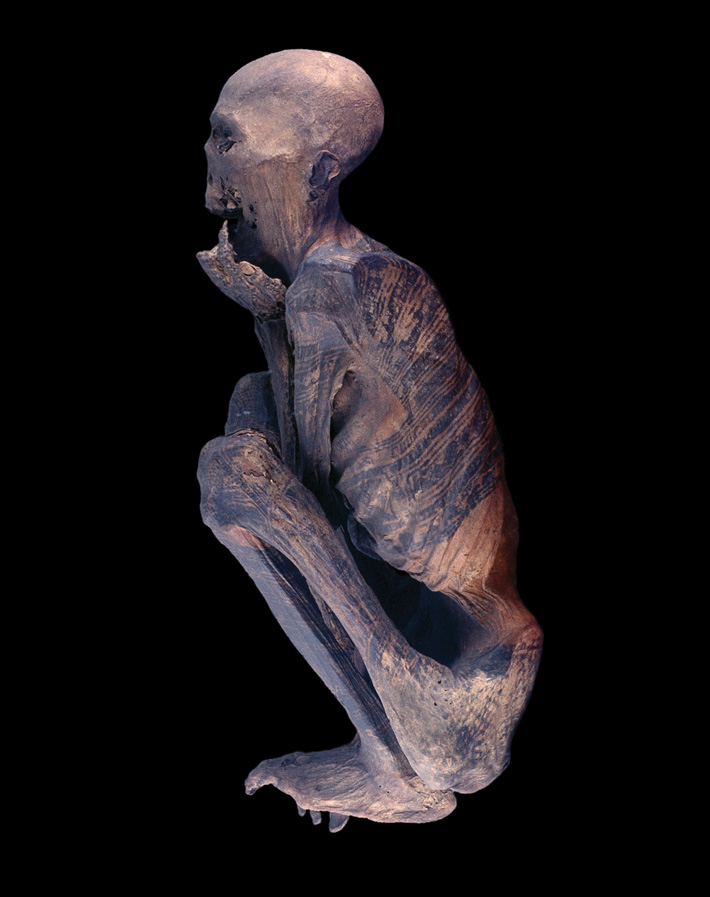 An indigenous people known as the Ibaloi once mummified their honored dead and laid them to rest in hollowed logs in the caves around what is now the Filipino municipality of Kabayan. In life, these ancient people had won the right to be covered in spectacular tattoos depicting geometric shapes as well as animals such as lizards, snakes, scorpions, and centipedes. “According to nineteenth-century ethnographic accounts, Ibaloi head-hunting warriors revered these creatures as ‘omen animals,’” says Smithsonian anthropologist and tattoo scholar Lars Krutak. “The sight of one before a raid could make or break the entire enterprise.” After successfully taking the head of an enemy in battle, a warrior would have these propitious animals permanently etched onto his body. Some Kabayan mummies also feature less fearsome tattoos, such as circles on their wrists thought to be solar discs, or zigzagging lines variously interpreted as lightning or stepped rice fields. “All these tattoos seem to depict the surrounding environment,” says Krutak, who notes that the increased attention paid to the mummies in the last decade has helped fuel a resurgence in traditional tattooing, which had largely died out. Today, thousands of people tracing their descent to the ancient Ibaloi wear designs on their skin modeled after those of their ancestors.
An indigenous people known as the Ibaloi once mummified their honored dead and laid them to rest in hollowed logs in the caves around what is now the Filipino municipality of Kabayan. In life, these ancient people had won the right to be covered in spectacular tattoos depicting geometric shapes as well as animals such as lizards, snakes, scorpions, and centipedes. “According to nineteenth-century ethnographic accounts, Ibaloi head-hunting warriors revered these creatures as ‘omen animals,’” says Smithsonian anthropologist and tattoo scholar Lars Krutak. “The sight of one before a raid could make or break the entire enterprise.” After successfully taking the head of an enemy in battle, a warrior would have these propitious animals permanently etched onto his body. Some Kabayan mummies also feature less fearsome tattoos, such as circles on their wrists thought to be solar discs, or zigzagging lines variously interpreted as lightning or stepped rice fields. “All these tattoos seem to depict the surrounding environment,” says Krutak, who notes that the increased attention paid to the mummies in the last decade has helped fuel a resurgence in traditional tattooing, which had largely died out. Today, thousands of people tracing their descent to the ancient Ibaloi wear designs on their skin modeled after those of their ancestors.
Advertisement
Advertisement
IN THIS ISSUE
Advertisement

Recent Issues
-
 May/June 2024
May/June 2024
-
 March/April 2024
March/April 2024
-
 January/February 2024
January/February 2024
-
 November/December 2023
November/December 2023
-
 September/October 2023
September/October 2023
-
 July/August 2023
July/August 2023
-
 May/June 2023
May/June 2023
-
 March/April 2023
March/April 2023
-
 January/February 2023
January/February 2023
-
 November/December 2022
November/December 2022
-
 September/October 2022
September/October 2022
-
 July/August 2022
July/August 2022
-
 May/June 2022
May/June 2022
-
 March/April 2022
March/April 2022
-
 January/February 2022
January/February 2022
-
 November/December 2021
November/December 2021
-
 September/October 2021
September/October 2021
-
 July/August 2021
July/August 2021
-
 May/June 2021
May/June 2021
-
 March/April 2021
March/April 2021
-
 January/February 2021
January/February 2021
-
 November/December 2020
November/December 2020
-
 September/October 2020
September/October 2020
-
 July/August 2020
July/August 2020
-
 May/June 2020
May/June 2020
-
 March/April 2020
March/April 2020
-
 January/February 2020
January/February 2020
-
 November/December 2019
November/December 2019
-
 September/October 2019
September/October 2019
-
 July/August 2019
July/August 2019
-
 May/June 2019
May/June 2019
-
 March/April 2019
March/April 2019
-
 January/February 2019
January/February 2019
-
 November/December 2018
November/December 2018
-
 September/October 2018
September/October 2018
-
 July/August 2018
July/August 2018
-
 May/June 2018
May/June 2018
-
 March/April 2018
March/April 2018
-
 January/February 2018
January/February 2018
-
 November/December 2017
November/December 2017
-
 September/October 2017
September/October 2017
-
 July/August 2017
July/August 2017
-
 May/June 2017
May/June 2017
-
 March/April 2017
March/April 2017
-
 January/February 2017
January/February 2017
-
 November/December 2016
November/December 2016
-
 September/October 2016
September/October 2016
-
 July/August 2016
July/August 2016
-
 May/June 2016
May/June 2016
-
 March/April 2016
March/April 2016
-
 January/February 2016
January/February 2016
-
 November/December 2015
November/December 2015
-
 September/October 2015
September/October 2015
-
 July/August 2015
July/August 2015
-
 May/June 2015
May/June 2015
-
 March/April 2015
March/April 2015
-
 January/February 2015
January/February 2015
-
 November/December 2014
November/December 2014
-
 September/October 2014
September/October 2014
-
 July/August 2014
July/August 2014
-
 May/June 2014
May/June 2014
-
 March/April 2014
March/April 2014
-
 January/February 2014
January/February 2014
-
 November/December 2013
November/December 2013
-
 September/October 2013
September/October 2013
-
 July/August 2013
July/August 2013
-
 May/June 2013
May/June 2013
-
 March/April 2013
March/April 2013
-
 January/February 2013
January/February 2013
-
 November/December 2012
November/December 2012
-
 September/October 2012
September/October 2012
-
 July/August 2012
July/August 2012
-
 May/June 2012
May/June 2012
-
 March/April 2012
March/April 2012
-
 January/February 2012
January/February 2012
-
 November/December 2011
November/December 2011
-
 September/October 2011
September/October 2011
-
 July/August 2011
July/August 2011
-
 May/June 2011
May/June 2011
-
 March/April 2011
March/April 2011
-
 January/February 2011
January/February 2011
Advertisement






